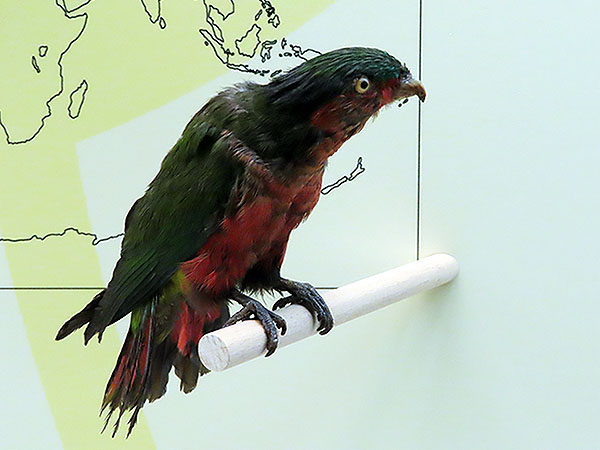While checking old papers regarding the enigmatic Divine Kingfisher from the island of Bora Bora, I found that the same paper mentions the existence of a lorikeet on the same island, well actually even two species of lorikeets, one being the Blue Lorikeet (Vini peruviana (Statius Müller)) and the other one being Kuhl’s Lorikeet (Vini kuhlii (Vigors)).
Or was it something else?
***
Well here are the original text passages.:
“On nous donna á Borabora une espèce vivante de perruche très-voisine du phigy de Levaillant …, peut-être encore plus voisine de la perruche fringillaire …, et que M. Vigors a décrite récemment … sous le nom de psittacula Kuhlii.
Cet oiseau, sur lequel nous fournirons de nouveaux détails dans la partie descriptive des espèces, a la langue terminée par un petit cercle de papilles nerveuses; ses habitudes sont vives et colériques, et son naturel sauvage.”
translated:
“We were given on Borabora a living species of parrot very close to the phigy of Levaillant …, perhaps even closer to the parakeet that Mr. Vigors has recently described … under the name of psittacula Kuhlii.
This bird, on which we will furnish new details in the descriptive part of the species, has the tongue terminated by a small circle of nerve papillae; his habits are lively and angry, and his temper is wild.”
and the second part:
“Cet oiseau a les narines en scissure et la langue terminée par un cercle de papilles longues, qu’on retrouve chez l’ Ari-manou. Il se nourrit de bananes, et son caractère est extrêmement colérique. Nous nous le sommes procuré dans l’île de Borabora.
Cette petite perruche à queue pointue a de longueur totale six pouces. Son bec et ses tarses sont orangés; le front est vert; les plumes de la tête et de l’occiput sont longues, étroites, d’un bleu céleste au sentre et frangées de noir sur les bords; les joues, le devant de la gorge et du cou, jusqu’au haut du ventre, sont d’un rouge vermillon mat: le milieu du ventre est aussi de ce même rouge, mais la région anale et les plumes des cuisses sont dún bleu pourpré. Le plumage est en entier d’un vert lustré clair, plus foncé et teint roussatre sur le manteau; la queue est jaune en-dessous et verte et jaune en-dessus. Les rémiges sont noires et vertes.”
translated:
“This bird has cracked nostrils and the tongue ends with a circle of long taste buds, found in the Ari-manou [?]. It feeds on bananas, and its character is extremely choleric. We obtained it on the island of Borabora.
This small parrot with a pointed tail has a total length of six inches [ca. 15,3 cm]. Its beak and tarsi are orange; the forehead is green; the feathers of the head and of the occiput are long, narrow, of a heavenly blue in the center, and fringed with black on the edges; the cheeks, the front of the throat and the neck, up to the upper part of the belly, are of a matt vermilion red: the middle of the belly is also of this same red, but the anal region and the feathers of the thighs are of a blue purple. The plumage is entirely lighter green, darker and reddish on the mantle; the tail is yellow below and green and yellow above. The flight feathers are black and green.”
***
Well, the description mostly fits with Kuhl’s Lorikeet, except for the color of the mantle (said to be darker and reddish; but is yellowish green in V. kuhlii), and the tail (said to be yellow below and green and yellow above; but is yellowish green and red in V. kuhlii).
So what do we have here?
Kuhl’s Lorikeet was once more widely distributed, this is a fact that is known, the bird inhabited mostly all of the Austral- and the Cook Islands, but what about the Society Islands?

There are also some old oral traditions from the Society Island published in 1928, mentioning at least seven different kinds of parrots, some can be identified as well-known species, others can’t.
***
My guess is, the likeliest possibility is that this parrot from Bora Bora may represent a now extinct subspecies of Kuhl’s Lorikeet from the Society Islands.
***
There’s a little update here as well:
The following small account is found in G. R. Gray’s ‘ Catalogue of the birds of the tropical islands of the Pacific Ocean in the collection of the British Museum’.:
“CORIPHILUS KUHLII
…
‘Ari-manou’ of the natives of the Society Islands.
Society Islands (Borabora); Sandwich Islands.” [2]
I thus changed the name of the supposed bird in the headline.
*********************
References:
[1] Teuira Henry: Ancient Tahiti. Bishop Museum Bulletins 48: 1-651. 1928 [2] M. L. I. Duperrey: Voyage autour du monde: Exécuté par Ordre du Roi, Sur la Corvette de Sa Majesté, La Coquille, pendant les années 1822, 1823, 1824, et 1825, par M. L. I. Duperrey; Zoologie, par Mm. Lesson et Garnot. Paris: Arthus Bertrand 1828
[2] George Robert Gray: Catalogue of the birds of the tropical islands of the Pacific Ocean in the collection of the British Museum. London: printed by order of the Trustees 1859
*********************
edited: 05.01.2023
